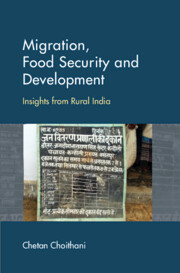Book contents
- Frontmatter
- Contents
- List of Figures, Tables and Boxes
- List of Photos
- Preface
- Acknowledgements
- List of Abbreviations
- 1 Introduction
- 2 Bridging the Disconnect between Migration and Food Security
- 3 Dynamics of Food Insecurity, Migration and Urbanisation in India
- 4 The Context of Migration
- 5 Connections between Food Safety Nets and Migration
- 6 Migration, Remittances, Land and Household Food Security
- 7 Opening the Household Box
- 8 Conclusion
- References
- Index
6 - Migration, Remittances, Land and Household Food Security
Published online by Cambridge University Press: 22 February 2023
- Frontmatter
- Contents
- List of Figures, Tables and Boxes
- List of Photos
- Preface
- Acknowledgements
- List of Abbreviations
- 1 Introduction
- 2 Bridging the Disconnect between Migration and Food Security
- 3 Dynamics of Food Insecurity, Migration and Urbanisation in India
- 4 The Context of Migration
- 5 Connections between Food Safety Nets and Migration
- 6 Migration, Remittances, Land and Household Food Security
- 7 Opening the Household Box
- 8 Conclusion
- References
- Index
Summary
INTRODUCTION
The development experience of most countries in the world suggests that economic growth is accompanied by structural transformation. As economies advance, the share of population chiefly dependent on agriculture declines. However, the outcomes of this structural transformation on rural and urban economies and societies are far from uniform, and they depend on the ways in which ‘the complexity of national diversity asserts itself’ (Timmer, 2007, p. 4).
The Indian experience of structural transformation appears peculiar. The market reforms from the 1980s (though beginning in earnest only in the early 1990s) put the Indian economy on the path of higher growth and are associated with increased overall prosperity. This has been accompanied by a structural shift in which the non-agricultural sector vis-a-vis the agricultural sector and urban areas vis-a-vis rural areas have gained significance in terms of their shares in national income. However, changes in employment patterns have not followed at an expected pace. The rural–urban transition is far from complete, and nearly 70 per cent of the country's population still lives in the countryside. And despite the fast-growing non-agricultural sector of the economy, the share of labour in agriculture has declined at a slower rate than the contemporary experience of other Asian countries suggests. The source of this apparent contradiction lies in the fact that much of the economic growth of the recent past is accounted for by more capital and skill-intensive business and service sectors, constraining the opportunities for the poor and unskilled populations to alter their livelihood pathways more fully.
India's distinctive structural transformation notwithstanding, the fundamental shifts that have characterised the Indian economy over the past three decades are rapidly altering rural livelihood trajectories in the country. Although agriculture still remains the single largest employment provider, the relative importance of agriculture as a primary source of income and food security has weakened. Between 2004 and 2016, there has been a net loss of 40 million jobs in agriculture with effects extending to 200 million rural dwellers (see Van Duijne and Nijman, 2019; Choithani, Van Duijne and Nijman, 2021).
Jobs and economic output are now increasingly concentrated in cities and towns. Most urban jobs are informal, but they provide an important buffer against livelihood losses in the rural agriculture sector. This means urban areas have assumed greater significance in the overall framework of the economy and job creation.
- Type
- Chapter
- Information
- Migration, Food Security and DevelopmentInsights from Rural India, pp. 181 - 234Publisher: Cambridge University PressPrint publication year: 2023



